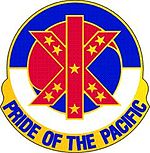| IX Corps | |
|---|---|
 Shoulder sleeve insignia of IX Corps | |
| Active | 1918-19 1921–50 1950-94 |
| Country | |
| Branch | |
| Motto(s) | Pride of the Pacific |
| Engagements | World War II Korean War |
| Commanders | |
| Notable commanders | Kenyon A. Joyce (1940–42) Emil F. Reinhardt (March−September 1944) Charles W. Ryder (1944–48) Leland Hobbs (1949–50) Frank W. Milburn (1950) John B. Coulter (1950–51) Bryant Moore (1951) Oliver P. Smith (1951) William M. Hoge (1951) Willard G. Wyman (1951–52) Joseph P. Cleland (1952) Reuben E. Jenkins (1952–53) Samuel T. Williams (1954) Carter B. Magruder (1954–55) James E. Moore (1955–58) John R. Guthrie (1975–77)[1] |
| Insignia | |
| Distinctive unit insignia |  |
| U.S. Corps (1939–present) | ||||
|
IX Corps was a corps of the United States Army. For most of its operational history, IX Corps was headquartered in or around Japan and subordinate to US Army commands in the Far East.
Created following World War I, the corps was not activated for use until just before World War II almost 20 years later. The corps spent most of World War II in charge of defenses on the West Coast of the United States, before moving to Hawaii and Leyte to plan and organize operations for US forces advancing across the Pacific. Following the end of the war, IX Corps participated in the occupation of mainland Japan.
The corps' only combat came in the Korean War. It is best known for its exploits as a senior command of the Eighth United States Army, commanding front line UN forces in numerous offensives and counteroffensives throughout the war. The corps served on the front lines for most of the conflict and took command of several combat divisions at a time. Following the end of the Korean War, IX Corps remained in Korea for several years until it was moved to Japan. The corps spent almost 40 years as an administrative command of the US Army forces there, overseeing administrative functions but no combat. It was finally inactivated and consolidated in 1994.
- ^ Varhola 2000, p. 278